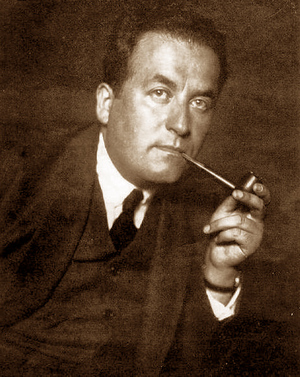In ancient Greece, the Greeks honored victors in athletic competitions and in poetic meets with a laurel wreath. In allusion to that honor, we call a winner of the Nobel Prize a 'Nobel Laureate.' Only one author of Modern Hebrew Literature is a Nobel Laureate: Shmuel Yosef Agnon (Shai Agnon, S.Y. Agnon), who was so honored in 1966.
Agnon was the first Israeli who won the Nobel Prize; eleven other Israelis in various other fields followed him, twelve Nobel Laureates in the 67-year-old state. Agnon was dedicated to his writing, he would work, sometimes, on the same story for several years, and even after its publication, he would continue to embellish and perfect it for a later edition.
Agnon wrote about Jewish life in Eastern Europe, Germany and Israel, and in his novels, novellas and short stories he integrated themes and material from traditional Jewish sources in what are modern literary works. He wrote powerfully about themes such as friendship, love, parents-child relationships, crisis as a cause for change.
Agnon (Galicia: Austro-Hungarian Empire, 1887 - Israel, 1970) was born to traditional, educated parents. In 1908, he immigrated to Mandatory Palestine where he published his first story. Just a few years later, he published a novella about Jewish life in East Europe and was recognized as a Hebrew writer of significance.
Agnon returned to Europe from 1912 to 1924, when he lived in Germany. It was during that period that he met his wife, Esther Marx, and Shlomo Zalman Schocken, a cultural activist who supported him financially, published his books and later made him a house-writer of his Hebrew newspaper, Ha'aretz. During that period, Agnon continued writing about traditional life in Eastern Europe and became a well-known Hebrew writer whose works were frequently translated to German.
During his last year in Germany, Agnon's home, which also housed his manuscripts, burned down in a fire. He returned to Palestine and lived in Jerusalem. He adopted a life of religious observance, building on his familiarity with traditional practices, which he knew from his youth. Five years after his return he again met with destruction when his library was destroyed during riots.
In the early 1930s Agnon came to be considered the leading Hebrew prose-writer after he published many short stories and a few very significant novels concerning traditional Jewish life in Galicia at the beginning of the 19th century, the disintegration of the Jewish life in Poland between the two World Wars, and life in Israel after the beginning of the modern Zionist movement.
The author wrote with a deep understanding of the inner life of his characters. He wrote surrealistic stories. In addition to his own work, he published several anthologies -- such as the Days of Awe: A Treasury of Jewish Wisdom for Reflection, Repentance, and Renewal on the High Holy Days.
After Agnon's death, his daughter, Emuna Yaron -- who died just last year -- brought to publication several works, which her father left unpublished. The posthumous publications include, for example, a book of letters, which Agnon had written to his wife, correspondence between Agnon and his publisher, essays and addresses, a few novels, and collections of shorter stories and legends. Some of these works preserved in print the life of Eastern European Jewry, depicting that world prior to the effects of modernization and annihilation.
In addition to literary awards and honorary doctorates, his literary work is part of the world of many Israelis, Agnon's image is imprinted on a bill of Israeli currency, streets are named after him, and a large collection of critical writing has come into being that consists of interpretations of his work. His novels, including The Bridal Canopy, A Simple Story, A Guest for the Night, Only Yesterday, his novellas such as In the Heart of the Seas and many of his short stories are part of the cultural world of our time.
Agnon shared the 1966 Nobel Prize in literature with Nelly Sachs, a Jewish poet and playwright who wrote in German. His work has been translated into English, French, German and other languages. Translation of Agnon's work is difficult because he has drawn extensively and intensively from many traditional Jewish sources -- The Hebrew Bible and its commentaries, rabbinic literature, Hassidic tales and concepts, traditional legal sources and legends - and there is a need to have knowledge of so many sources in order to truly understand his works. It is often easier to read well-selling translations of various other outstanding contemporary Israeli authors such as Amos Oz, A. B. Yehoshua, David Grossman, Etgar Keret and Zeruya Shalev.
When a radio broadcaster notified Agnon that he was awarded the Nobel Prize, Agnon commented that writing one proper page of Hebrew ("The Holy Tongue") was more important to him than all the prizes in the world. He said that he welcomed the prize nevertheless because he was a man who hardly made a living, and that he would do anything he could to bring honor to the State of Israel.
How challenging and rewarding was the life of Agnon since his first publication (1903) until he became one of 112 Nobel Laureates in Literature between 1901 and 2015!
The king of Sweden, Gustaf Adolf VI, handed the Nobel Prize to Agnon at the official banquet at the City Hall in Stockholm, "for his profoundly characteristic narrative art with motifs from the life of the Jewish people."
At the ceremony, one could see Agnon wearing a skullcap; attentive:
You can also listen to Agnon's speech at the Banquet, in English translation:


